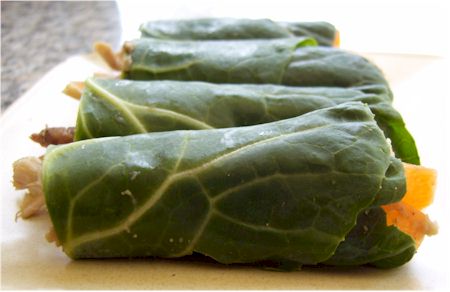Are Collard Greens a Better Source of Calcium Than Milk?
How much calcium we really need is a topic for another day. The fact of the matter is, many people are in hot pursuit of calcium, and they fear that a milk-free diet will leave them void. A recent article from Care2Health proclaimed that in terms of calcium, “Collard Greens Have More than Milk.” So is this true? Could greens actually be a good bone-building source? Yes and no, and yes. Let me explain.
According to the Harvard School of Public Health, 1 cup of collard greens contains 357 mg of calcium versus 306 mg of calcium in dairy milk. But the article fails to mention that this is 1 cup of cooked collards (nor do they mention the weight of their 1 cup). That is a lot of green for anyone to choke down, considering an entire bunch of collard green leaves can widdle down to 1/2 cup once cooked. So it may not be realistic for many people to expect to consume that much calcium from collard greens. Also the reports of “how much” calcium seem to vary widely. The USDA nutrition database states that 1 cup of cooked collards (weighing in at 190 grams or 6.7 ounces) contains 266mg of calcium, while 1 cup of raw collards (weighing in at 36 grams or 1.3 ounces) contains 52mg of calcium.
But, those big leaves do have more to offer our bones than just calcium. Yes, even 1/2 cup of cooked collards (or 2 cups of raw) would be considered a great source of calcium, but you will also get a good dose of Vitamin K.
Another blip from those folks at Harvard, “Vitamin K, which is found mainly in green, leafy vegetables, likely plays one or more important roles in calcium regulation and bone formation. Low levels of circulating vitamin K have been linked with low bone density …” Collard Greens are an excellent source of Vitamin K, along with a host of other great vitamins and minerals. And, as the people at Cooking Light point out, Kale has similar bone-building benefits.
To note – Kale actually has a higher absorption rate of calcium (our bodies are able to use more of it per mg) than milk!
Okay, there is just one more issue – taste. I love Swiss chard, spinach, romaine, and other neutral tasting greens, but those really dark leaves, like kale and collards are often a bit bitter for my taste buds. Nonetheless, I do find them enjoyable when paired with different flavors to counteract their bitterness. I make a carrot, purple cabbage, and kale saute with a touch of maple for a truly award-winning cooked salad. And as for those collards, they are new to me (as a Northwesterner, I didn’t grow up with collard greens, but they keep appearing in my CSA!), but I am experimenting and have found some great recipes to look forward to:
- Collard Wraps with Sunflower Seed Pate
- Collard Greens and Hummus Mini-Wraps
- 5-Star Garlic Simmered Collard Greens
- Vegan Collard Green Tamales
- Martha’s Sauteed Collard Greens w/ Raisins
- Billy’s Favorite Smoky Collard Greens
- Collard Green Slaw

If you have Kale to experiment with, trial one of these dairy-free recipes:
- Averie’s Raw Cheesy Kale Chips
- Kalyn’s Sea Salt and Vinegar Kale Chips
- Kale and Sweet Potato Salad w/ Warm Bacon Dressing
- Collard-Style Kale and Shiitake Mushrooms
For more information on building healthy bones, including calcium charts, nutritional studies, and more, see the Calcium and Strong Bones chapter in my book, Go Dairy Free.
Do you have any kale or collard recipes to share? Feel free to link in the comments!
Fitness Log:
Friday – Insanity Cardio Power & Resistance 40 min, 2.5 mile walking with husband.
Saturday – Insanity Pure Cardio 40 min, Insanity Cardio Abs 15 min, 2.5 mile walking and 4 mile bike ride with Tony.










I make this dish I called Christmas Kale – it just sauteed kale and beets with cinnamon and maple syrup. It’s more fall flavored though.
I just made collard wraps for the first time last week. I’m going to post about it…sometime. Soon.
Katie – That sounds fantastic! I love sweet contrast with kale. I’ll keep an eye out for that collard recipe!
GREAT info! I think 1 cup of cooked collards would be a good chunk to get down. I have been wanting to try kale chips so bad! I’ve heard so many good things
thanks for the linky love and glad you pointed out that collards are new to you. trust me, growing up in MN, collards were not a native green. Very little other than snow and ice is! Anyway though, your wraps look great. I have always been resistant to make collard wraps b/c i fear them being tough. I have tried to make cabbage leaf wraps and the leaves dont roll too well, so rice paper wraps are my ticket 🙂 but collards now may be on the radar provided they’re not tough!
Averie – The collards I had were from a CSA and weren’t tough at all, quite tender and pliable in fact, but you can always lightly steam them to soften.
hope you enjoy my recipe for “Collard-Style Kale and Shiitake Mushrooms”–I’m pretty sure the fat content negates the beneficial calcium levels in my imaginary “good for you rubric,” but it tastes awfully good
Receive New Posts via Email
Recent Posts
Calendar of Posts
Blogroll
Categories
Most Commented
Pages
Blogroll